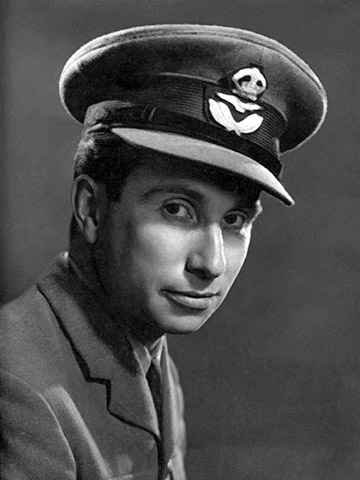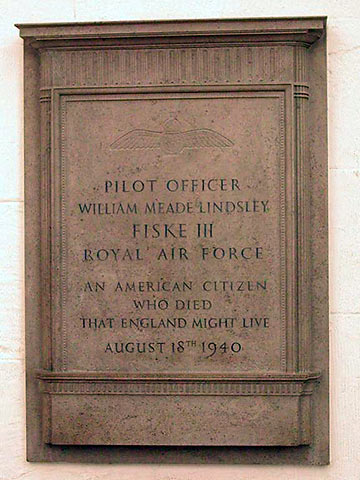|
Honoring American Pilot
Billy Fiske of the RAF By John Clayton
It almost moved me to tears when I first saw it, as I observed it was located near one of England's most illustrious military figures, the Duke of Wellington's massive sarcophagus in St Paul's. The day I visited St Paul's it was lacking tourists. Strange I thought, as it's one of the most visited attractions in London. In a way I was glad it was so peaceful, as it gave me time to reflect on the fact that an American had a special and honored place in British history. As the quietness drifted over the masterpiece of architectural brilliance of Sir Christopher Wren, who designed and built St Paul's in the late 17th century, I knew I had to find out more about the first American fighter pilot killed in action in WW2.
Billy was born in 1911, in New York, the son of a banking magnate and spent part of his education in France where, in 1924, he discovered the sport of Bobsledding. He was so enamored of the sport that at only 16 years of age he became the driver of the 1928 US Olympic Bobsled team in St. Moritz, Switzerland, and was the youngest gold medalist in any winter sport until being eclipsed by Toni Nieminen in 1992. When WW2 broke out Billy "yearned for the action of that conflict" and, pretending to be Canadian, he joined the Royal Air Force Volunteer Reserve, being promoted to the rank of Pilot Officer in March, 1940. I wonder how many people today do something that seems as old fashioned as a horse drawn buggy – keeping a diary. Well Billy did, and when he was accepted into the RAF he wrote in his diary "I believe I can lay claim to being the first US citizen to join the RAF in England after the outbreak of hostilities." He was one of 7 American pilots who fought in the historic Battle of Britain. Not more than 5 months later, on August 16th, 1940, Billy Fiske and his fellow pilots of the RAF's 601 Squadron based at RAF Tangmere, West Sussex, were scrambled to intercept a large number of German Junkers JU 87 Stukas. A furious aerial gunfight took place and, after a scant 15 minutes, one of the German dive bombers put a bullet into his Hurricane's fuel tank. Instead of bailing out, Fiske managed to get his heavily damaged aircraft headed back towards his base – barely able to clear some homes, he put the Hurricane down on Tangmere's field. His hands and feet were badly burned, and it took six ground crew to carefully extract him from the cockpit.
He was rushed to the Royal West Sussex Hospital in Chichester for treatment. 48 hours later, and unable to recover from his wounds, Billy died. He was just 29 years old. If you go to St Paul's – and I hope you do – find Billy's plaque and you'll see these heart tugging words. "Pilot Officer William Meade Linsley, FISKE III, Royal Air Force. An American citizen who died so that England might live. August 18th, 1940." Attended by many famous notables of the day, the plaque was unveiled – appropriately – on July 4th, 1941. Related Articles: |
 hen
you first see the plaque you might wonder how on earth Billy Fiske,
an American Olympic champion, and the son of a wealthy New York City
banker, was flying British Hurricane fighters in 1940, during "The
Battle of Britain" in World War Two. Especially when you know that
America was still nearly a year and a half away from entering that war.
Even more extraordinary is that when Fiske died the British were so
overcome with gratitude for his bravery and willingness to fight for
freedom, they not only created the aforementioned special plaque about
him, but placed it in Britain's iconic St Paul's Cathedral in
hen
you first see the plaque you might wonder how on earth Billy Fiske,
an American Olympic champion, and the son of a wealthy New York City
banker, was flying British Hurricane fighters in 1940, during "The
Battle of Britain" in World War Two. Especially when you know that
America was still nearly a year and a half away from entering that war.
Even more extraordinary is that when Fiske died the British were so
overcome with gratitude for his bravery and willingness to fight for
freedom, they not only created the aforementioned special plaque about
him, but placed it in Britain's iconic St Paul's Cathedral in 


